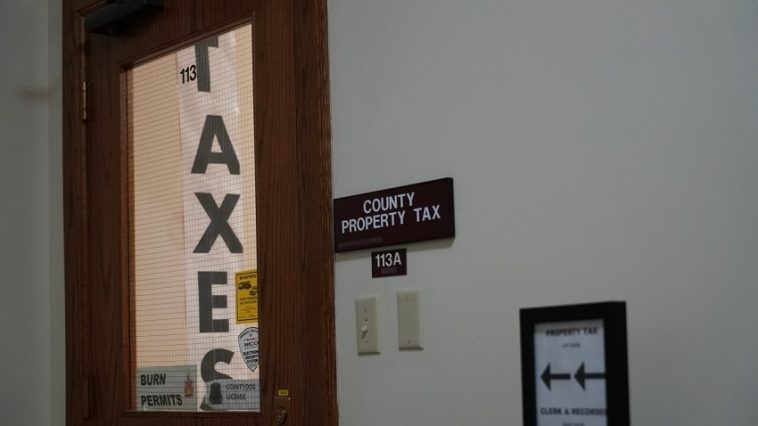Missoula, MT – As the Montana Legislature’s 69th session enters its final stretch, with just ten working days remaining, one of the most debated issues continues to be property tax relief. Lawmakers are now closer to a resolution, with two competing bills—SB 542 and HB 231—both advancing through their respective chambers, although they still contain key differences.
On Tuesday evening, the House and Senate each debated a different property tax reform proposal, both of which passed initial votes. The House voted 80-20 to advance SB 542, a bill that House Majority Leader Rep. Steve Fitzpatrick (R-Great Falls) called the “flagship bill.” Meanwhile, the Senate narrowly approved HB 231, 26-24, after the bill had previously failed but was revived for further consideration.
Despite the differences between the two bills, both share a similar framework for property tax relief. They introduce “homestead tax rates,” which are modeled after Governor Greg Gianforte’s preferred approach. These rates would offer a tax advantage for Montanans’ primary residences, long-term rentals, and small commercial properties. Additionally, both bills include a one-time rebate of up to $400 for property owners this year.
However, significant disagreements remain regarding how tax rates will be structured for 2025. Since the Montana Department of Revenue is unlikely to fully implement the homestead tax rates this year, SB 542 proposes a graduated tax rate system for residential properties, with higher rates for higher-valued homes. In contrast, HB 231 would apply a uniform rate to all residential properties for the year.
The bills’ potential impact on property owners is complex. Property taxes are determined by a rate applied to a property’s assessed value, and the taxable value is then multiplied by a mill rate set by local governments. If a bill reduces a tax rate, local governments may adjust the mill rate to maintain revenue levels, meaning that a reduction in the tax rate does not always translate to an equivalent reduction in a property owner’s tax bill.
Currently, residential properties are taxed at a rate of 1.35%. Under the proposed homestead rates, Montanans’ primary homes and long-term rentals valued at or below the statewide median—around $340,000—would see a reduced rate of 0.76%. For properties valued higher than the median, the tax rate would remain at 0.76% up to the median value, then gradually rise to 1.9% for any value exceeding four times the median. For second homes and short-term rentals, the rate would be 1.9% on the entire property value.
The commercial tax rate, which is currently 1.89%, would be adjusted under the proposed bills to 1.5% for properties valued below six times the median and 1.9% for those valued higher.
Fitzpatrick, during Tuesday’s debate, cited models from the Department of Revenue that indicated the homestead tax rates would lead to tax cuts ranging from 20% to 40% for the average primary residence in most Montana counties. However, these tax reductions would be lower in counties with higher property values, such as Gallatin and Missoula.
One of the major concerns with these proposals is the potential for a tax shift. As some property owners see reduced tax rates, the tax burden would shift to other property types, particularly second homes, large commercial and industrial properties, and agricultural or forest land. This shift has raised concerns among business and agricultural groups, including the Montana Chamber of Commerce, which has voiced apprehension about the bills’ impact on businesses, farms, and ranches.
In a letter to lawmakers, the Chamber argued that the proposed tax changes would offer only modest relief to residential property owners while imposing tax increases on businesses and agriculture. They also warned that the relief for homeowners would diminish as residential property values continue to rise.
Supporters of SB 542 and HB 231, however, argue that businesses and large property owners have already benefitted from lower property taxes in recent years due to shifts in the tax burden caused by rising residential property values. Fitzpatrick pointed to the example of Northwestern Energy, whose property taxes have decreased by approximately $35 million in recent years, suggesting that even with the changes, large businesses would still pay less than they did in 2022.
Some lawmakers remain opposed to the homestead tax model, preferring alternatives such as Senate Bill 90, which would use state taxes from tourism-related activities like hotel stays and rental cars to fund property tax credits. However, SB 90 has faced significant opposition, and efforts to bring it back to the table have so far been unsuccessful.
As the session winds down, SB 542 and HB 231 will face additional debates and votes in their respective chambers. If both bills pass in their current forms, they could quickly reach Governor Gianforte’s desk for approval. If the chambers cannot agree on the final versions of the bills, they will be sent to a conference committee for further revisions.
While the future of Montana’s property tax reform remains uncertain, lawmakers are hopeful that they can arrive at a solution that balances relief for homeowners with the needs of businesses and other property owners.



